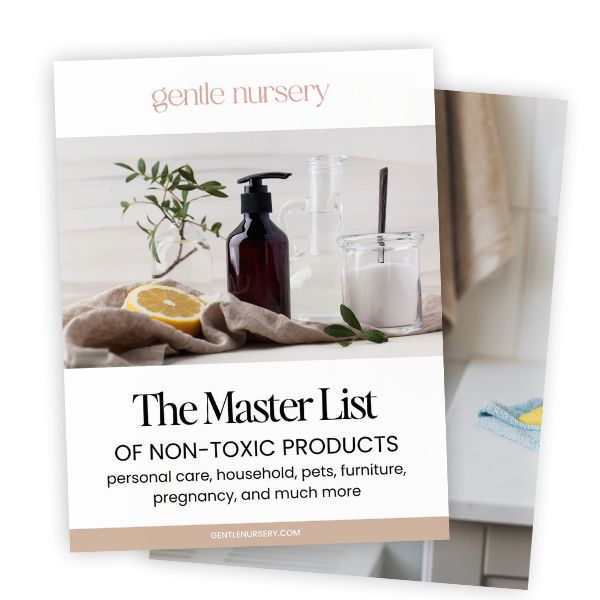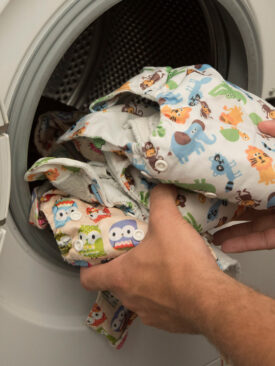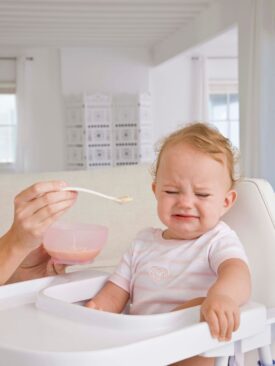You may have heard of perfluorinated chemicals (aka PFAS or PFCs) and wondered just how hazardous they are. As a parent, it’s important to understand how PFAS can affect your children’s health and how to limit exposure to these chemicals.
Perfluorinated chemicals (PFCs) are a class of compounds found all around us. Unfortunately, they’re also toxic, especially for babies and children. Worst of all, they cause long-lasting health effects.
Read on to learn where you can find perfluorinated chemicals, what they do, and how to avoid them.
What are Perfluorinated Chemicals?
Perfluorinated chemicals are molecules that contain lots of fluorine. Because of their structure, they tend to repel many other chemicals, such as water, grease, and oil. This makes PFCs great for both nonstick cookware and making stain-resistant carpet, furniture, and clothing. Even food packaging, like paperboard burrito bowls and cheeseburger wrappers, are often treated with PFCs. But the problem is that these chemicals are also endocrine disruptors.
Endocrine disruptors like PFCs affect hormone behavior in our bodies. Many of these chemicals bioaccumulate (stay in your body for a long time). And our bodies tend to store PFCs in our body fat (which we all have, regardless of our size). But the scary thing is, these chemicals don’t degrade. Nicknamed the “forever chemical,” once they’re made, they stick around in both the environment and our bodies.
Because of their persistence, PFCs also biomagnify (increase in concentration up the food chain). For example, krill or shrimp may absorb PFCs from seawater. If fish eat several of these, and then larger fish eat several smaller fish, the larger fish will contain lots of PFCs. When we eat one of these large fish, we also consume large amounts of polyfluorinated chemicals.
Why Are Perfluorinated Chemicals Extra Dangerous for Babies and Children?
Generally speaking, children and babies (even before they are born) are much more susceptible to the effects of perfluorinated chemicals than adults. Their brains, metabolic systems, and reproductive systems are still developing, so their systems and organs can be majorly affected by toxins.
It certainly doesn’t help that parents often use stain-resistant products when they have babies around. And unfortunately, furniture, mattress covers, and flooring can all contain PFCs. So, when your baby is crawling around on the floor, or mouthing a toy that was on the floor, they can potentially be consuming PFCs.
Most concerning of all is that both infant formula and breastmilk can contain perfluorinated chemicals. It’s virtually impossible to avoid all exposure to these compounds.
How Can Perfluorinated Chemicals Affect Kids?
PFCs affect kids in multiple ways, although many of these effects may not be seen until puberty or even adulthood.
Reproductive Effects
Because many endocrine disruptors mimic sex hormones, they can affect development during puberty. For example, these compounds affect the male reproductive system, possibly causing issues that can lead to infertility.
Metabolic Effects
In addition, endocrine disruptors have a huge effect on a child’s metabolism (something we’re still learning about). These compounds change how we use the food we digest, and likely have a part to play in common American problems like obesity, diabetes, cholesterol levels, and cardiovascular health.
In addition, PFCs can affect thyroid levels. And because the thyroid regulates functions throughout your whole body, this can have a huge effect on your metabolism.
Immune System Effects
Perfluorooctanyl sulfonates (PFOS) can also affect the immune system function. And PFAS in the body can lead to a greater risk of autoimmune disorders, as well as lowered response to vaccines (meaning they’re less likely to work).
Cancer
Finally, PFCs cause an increased risk of several cancers, particularly testicular and kidney cancer.
Main classes of PFCs
There are several compounds that fall under perfluorinated chemicals. Here are the main ones to look out for (and how to avoid them).
PFAS
PFAs are a group of man-made chemicals. The two best-known examples from this class are perfluorooctane sulfonate (PFOS) and perfluorooctanoic acid (PFOA).
Unfortunately, PFAs are everywhere, and you can’t really avoid them altogether. Switching from plastic to paperboard, for example, won’t decrease your exposure. Many paperboard containers (like used for rice bowls and burrito bowls at take-out restaurants) contain perfluoroalkyl substances (PFAS). Typically, these chemicals are used in products to waterproof and grease-proof your cardboard bowls, and there can be a huge amount of them even in just one bowl. These bowls might seem more environmentally friendly because the paperboard will break down after being disposed of. But the PFAS will remain behind for thousands of years.
In addition, PFAS have been found in drinking water, particularly near industrial plants that use PFAs during manufacturing. These chemicals have been linked to preeclampsia (high blood pressure during pregnancy), high cholesterol, and asthma. They don’t break down in the environment, and they stay in your body for years.
How to Avoid Perfluorinated Chemicals
While PFCs are in many products, there are simple ways to avoid them.
Avoiding PFCs in Food
Prepare your food at home. Fast-food and takeout packaging often contains PFAS, so eating at home lets you avoid the highest concentrations of these compounds. In particular, skip microwave popcorn; the bags are coated with PFAS.
Focus on fresh fruits and vegetables, as well as meats, dairy, and grains you cook yourself. Since these foods have less packaging, they’re less likely to have PFCs in them.
What you use to cook your food matters, too. Avoid Teflon or other synthetic non-stick pans. While Teflon itself isn’t toxic, overheating it (to 450℉ or more) can cause the coating to break down, releasing toxic PFAS into your home air. Instead, use stainless steel cookware or cast iron.
Avoiding PFCs in your Home
Avoid brands of furniture and carpet that have stain-resistant coatings, as these likely are made with PFCs. In addition, don’t let salespeople upsell you an aftermarket stain-resistant coating for furniture or flooring (or at least learn whether the treatment contains PFCs).
Get rid of anything made with Scotchgard (from 3M) from 2002 or earlier, as it contains PFAS.
Avoiding PFCs in your Clothing
Be careful of water-resistant or waterproof jackets. Many are made with a PFC coating. Jack Wolfskin is a great brand that’s PFC-free.
Be aware of waterproofing on your kid’s snow gear as well. Once again, Jack Wolfskin has some great options for kids, and they’re super cute.
Avoiding PFCs in Drinking Water
Especially if you live in an industrial area, it’s important to make sure you’re not being exposed to these chemicals from your water when drinking or cooking. Use a carbon filter to remove contaminants from your drinking water.
Related: How to Reduce Your Baby’s Exposure to Pesticides
The Bottom Line
Definitely try to limit your family’s exposure to PFCs as much as possible by taking steps to avoid these yucky chemicals. Fortunately, the best ways to avoid these compounds are similar to other ways to protect your health: eat real, minimally processed food and only buy from companies whose products you know and trust.
Any more questions on PFCs? Be sure to let us know in the comments!
Keep Reading:










Leave a Reply